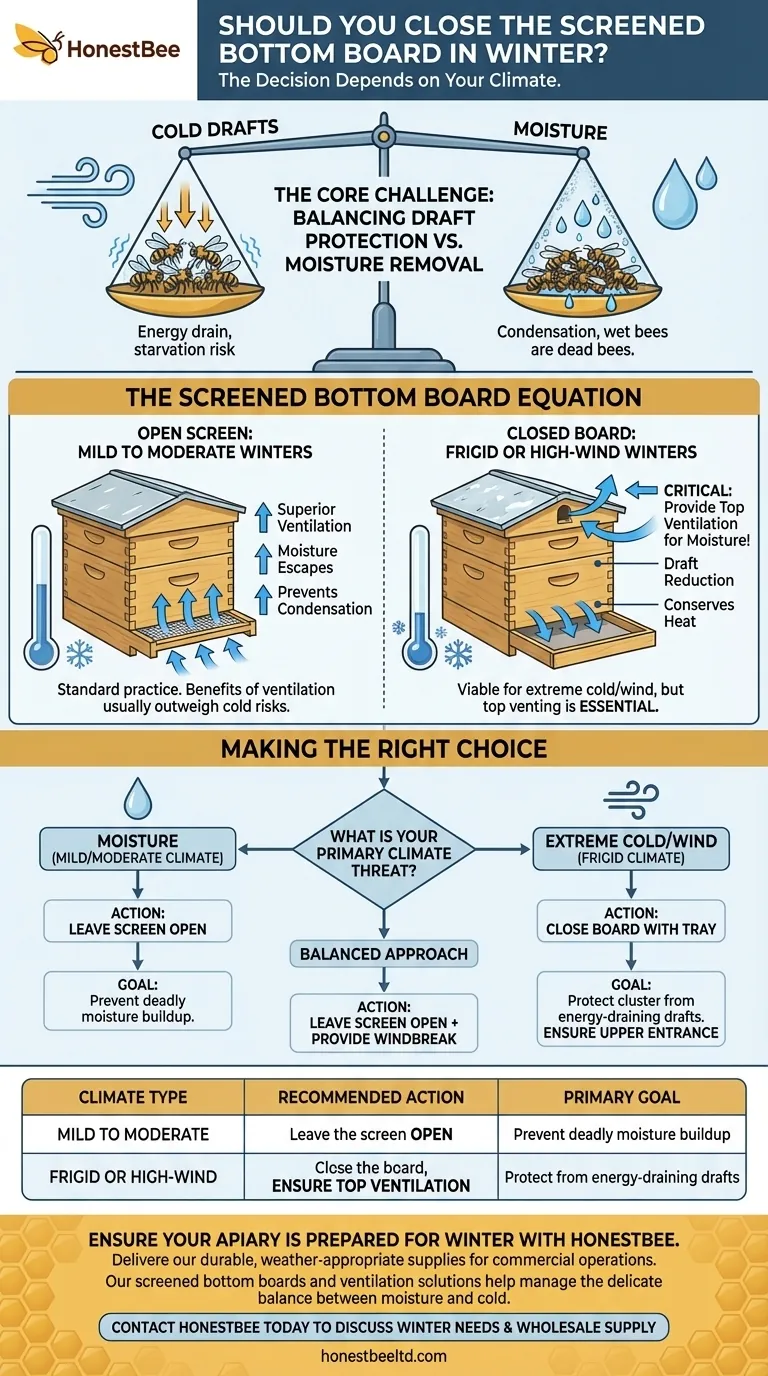The decision to close a screened bottom board in winter depends entirely on your local climate. For beekeepers in mild to moderate winters, leaving the screen open is often the best practice. In truly frigid, high-wind regions, closing the board can help the colony conserve energy, but only if you ensure adequate top ventilation is present to handle moisture.
The core challenge of wintering bees is not the cold itself, but managing moisture. Your decision on the bottom board should be guided by which threat—a cold draft from below or deadly condensation from above—is the greater risk in your specific location.

The Two Primary Winter Threats to a Hive
To make an informed decision, you must understand the two forces at play inside a winter hive: cold and moisture. While they are related, one is typically far more dangerous than the other.
The Danger of Cold Drafts
A honey bee cluster generates its own heat by vibrating flight muscles. A constant, cold draft from below can act like a radiator, wicking this precious heat away.
This forces the bees to consume more of their winter honey stores to maintain the cluster's core temperature, increasing the risk of starvation.
The Greater Danger of Moisture
Bees metabolizing honey release significant amounts of warm, moist air through respiration. As this air rises and hits the cold inner surfaces of the hive, it condenses into water.
If this condensation drips back down onto the bees, it will chill and kill the cluster far more effectively than cold air alone. Wet bees are dead bees.
How a Screened Bottom Board Changes the Equation
A screened bottom board fundamentally alters the hive's internal environment, offering distinct advantages and disadvantages for winter.
The Case for Leaving It Open: Superior Ventilation
The primary benefit of an open screen in winter is excellent moisture control.
The heavy, moisture-laden air, along with carbon dioxide, can exit through the bottom of the hive. This passive ventilation drastically reduces the chances of condensation forming at the top of the hive.
The Case for Closing It: Draft Reduction
Closing the board, typically by sliding in the mite-check tray, creates a solid floor.
This action stops direct wind from blowing up into the cluster. In relentlessly cold and windy conditions, this can be the crucial factor that helps the bees conserve enough honey to survive until spring.
Understanding the Trade-offs by Climate
Your geographic location is the single most important factor in this decision. There is no one-size-fits-all answer.
For Mild to Moderate Winters
In regions where temperatures are not consistently severe, the risk of condensation is a much greater threat than the cold itself.
For these climates, leaving the screened bottom board open is the standard and recommended practice. The ventilation benefits almost always outweigh the risk of the cluster getting too cold.
For Frigid or High-Wind Winters
In truly cold northern climates or locations exposed to constant wind, the energy drain from drafts becomes a serious concern.
In this scenario, closing the bottom board is a viable strategy. However, it is critical that you provide another path for moisture to escape, such as a small upper entrance or a ventilated inner cover. Trapping moisture in a cold hive is a death sentence.
Making the Right Choice for Your Apiary
Ultimately, your goal is to balance draft protection with moisture removal. Observe your specific conditions and choose the strategy that best mitigates the primary threat in your area.
- If your primary focus is preventing moisture buildup in a moderate climate: Leave the screened bottom board open all winter.
- If your primary focus is protecting the cluster from extreme cold and wind: Close the board with the insert tray, but ensure you have an upper entrance for ventilation.
- If you want a balanced approach in a colder climate: Consider leaving the screen open but providing a windbreak around your hives to reduce the impact of direct wind.
Understanding these principles empowers you to create the best possible conditions for your colony's survival.
Summary Table:
| Climate Type | Recommended Action | Primary Goal |
|---|---|---|
| Mild to Moderate Winters | Leave the screen open | Prevent deadly moisture buildup |
| Frigid or High-Wind Winters | Close the board, ensure top ventilation | Protect the cluster from energy-draining drafts |
Ensure your apiary is prepared for winter with the right equipment from HONESTBEE.
We supply durable, weather-appropriate beekeeping supplies and equipment to commercial apiaries and distributors through our wholesale-focused operations. Proper winterization is critical for colony survival and honey production. Our screened bottom boards and ventilation solutions are designed to help you manage the delicate balance between moisture and cold.
Let our experts help you choose the right equipment for your specific climate and operational scale. Contact HONESTBEE today to discuss your winter beekeeping needs and secure your wholesale supply.
Visual Guide

Related Products
- Langstroth Screen Bottom Board for Beekeeping Wholesale
- Australian Pine Wood Langstroth Screen Bottom Board for Wholesale
- Langstroth Solid Bottom Board for Beekeeping
- Professional Insulated Winter Hive Wrap for Beekeeping
- HONESTBEE Classic Pry Bar Hive Tool with High Visibility Finish for Beekeeping
People Also Ask
- What are the benefits of using a screened bottom board in warm or humid climates? Boost Hive Health & Control Pests
- What are some considerations when choosing between solid and screened bottom boards? Optimize Hive Health & Pest Control
- What are the benefits of a screened bottom board? Boost Hive Health & Control Varroa Mites
- What are the main benefits of using a Screened Bottom Board in beekeeping? Enhance Hive Health & Productivity
- What are the advantages of a screened bottom board? Boost Hive Health with Superior Ventilation & Pest Control



















